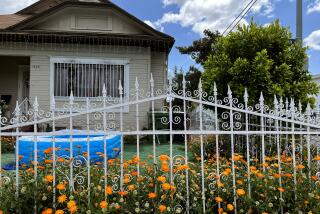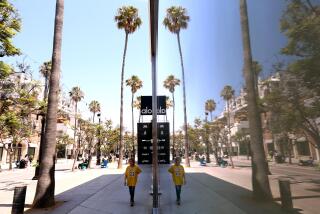Where whimsy and practicality meet
The small triangle where Main and Spring streets intersect downtown has the feel of an Edward Hopper scene -- the merging of two grand urban canyons lined by old buildings and inhabited by bustling street life.
But the streetscape has changed dramatically in recent weeks, with workers erecting a median strip that grabs the attention of almost anyone who passes by, invoking as it does both the fantastical mind of Dr. Seuss and the earthbound pragmatism of horticulturalist Theodore Payne.
Bright green and blue hemispheres jut out from the ground and will be lighted at night so they look as if they were hovering over the street. They are interspersed with three floss silk trees, their trunks green and spiky, and ice plant with vibrant pink flowers.
The new median “wasn’t what we were thinking about, but wow,” said Kent Smith, executive director of the L.A. Fashion District Business Improvement District. “It’s certainly going to be eye-catching and will certainly be something you notice when you drive by. It’s a real conversation starter.”
It’s unclear exactly why Spring and Main streets intersect as they do. One theory is that it’s where two street grids intersect; another is that sewer systems had something to do with it.
The seminal city map of Los Angeles, drawn by Edward Ord in 1849, does not show the intersection; in fact, most of downtown is not planned out south of 5th Street.
But a later map, from 1887, does feature the triangle-shaped merging of the two streets. (For the name of the road continuing south, Main Street, being the main street, won out.)
These days, the intersection sits at the edge of the booming fashion district. That presented both a challenge and an opportunity, said Tom Lockett of the design firm Land Images, which worked on the project for both the city Department of Transportation and the Metropolitan Transportation Authority. The goal, he said, was to do something “that was a little bit unique, perhaps reflective of the spirit and activity that goes on in that part of the world.”
Still, the project presented its own challenges. Because of its location, it needed to be visible -- an attention grabber for both drivers and pedestrians. It needed to withstand the inevitable encroachment of a driver onto the strip. And it needed to be easy to manage.
For those reasons, Lockett said, designers chose the low-water plants and decided to use concrete and recycled colored glass for the hemispheres. (The colors come from the different containers that were crushed and recycled.) The entire project cost about $380,000 and was funded by a grant from the MTA.
“We felt the product would not just be cool to look at but very easy to manage,” Lockett said. “And you can just hose it off to clean it.”
Smith said the business improvement district will be responsible for the median’s maintenance and lighting. Officials hope it will help create a pedestrian-friendly environment in the area, which has surged in recent years with new restaurants, nearby loft buildings and a renewed interest in the fashion district.
--


